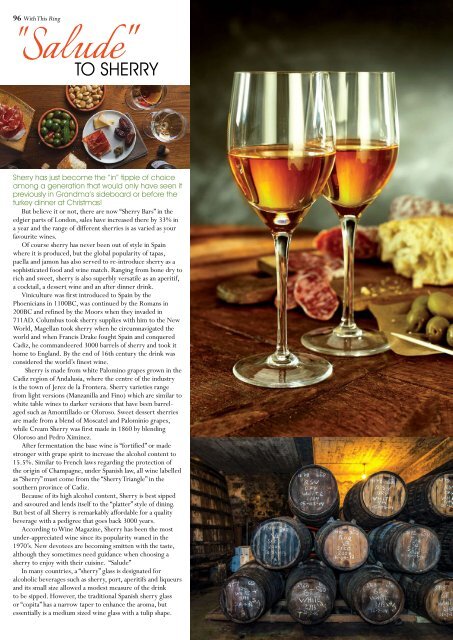With This Ring: August 05, 2016
Create successful ePaper yourself
Turn your PDF publications into a flip-book with our unique Google optimized e-Paper software.
96 <strong>With</strong> <strong>This</strong> <strong>Ring</strong><br />
Sherry has just become the “in” tipple of choice<br />
among a generation that would only have seen it<br />
previously in Grandma’s sideboard or before the<br />
turkey dinner at Christmas!<br />
But believe it or not, there are now “Sherry Bars” in the<br />
edgier parts of London, sales have increased there by 33% in<br />
a year and the range of different sherries is as varied as your<br />
favourite wines.<br />
Of course sherry has never been out of style in Spain<br />
where it is produced, but the global popularity of tapas,<br />
paella and jamon has also served to re-introduce sherry as a<br />
sophisticated food and wine match. Ranging from bone dry to<br />
rich and sweet, sherry is also superbly versatile as an aperitif,<br />
a cocktail, a dessert wine and an after dinner drink.<br />
Viniculture was first introduced to Spain by the<br />
Phoenicians in 1100BC, was continued by the Romans in<br />
200BC and refined by the Moors when they invaded in<br />
711AD. Columbus took sherry supplies with him to the New<br />
World, Magellan took sherry when he circumnavigated the<br />
world and when Francis Drake fought Spain and conquered<br />
Cadiz, he commandeered 3000 barrels of sherry and took it<br />
home to England. By the end of 16th century the drink was<br />
considered the world’s finest wine.<br />
Sherry is made from white Palomino grapes grown in the<br />
Cadiz region of Andalusia, where the centre of the industry<br />
is the town of Jerez de la Frontera. Sherry varieties range<br />
from light versions (Manzanilla and Fino) which are similar to<br />
white table wines to darker versions that have been barrelaged<br />
such as Amontillado or Oloroso. Sweet dessert sherries<br />
are made from a blend of Moscatel and Palominio grapes,<br />
while Cream Sherry was first made in 1860 by blending<br />
Oloroso and Pedro Ximinez.<br />
After fermentation the base wine is “fortified” or made<br />
stronger with grape spirit to increase the alcohol content to<br />
15.5%. Similar to French laws regarding the protection of<br />
the origin of Champagne, under Spanish law, all wine labelled<br />
as “Sherry” must come from the “Sherry Triangle” in the<br />
southern province of Cadiz.<br />
Because of its high alcohol content, Sherry is best sipped<br />
and savoured and lends itself to the “platter” style of dining.<br />
But best of all Sherry is remarkably affordable for a quality<br />
beverage with a pedigree that goes back 3000 years.<br />
According to Wine Magazine, Sherry has been the most<br />
under-appreciated wine since its popularity waned in the<br />
1970’s. New devotees are becoming smitten with the taste,<br />
although they sometimes need guidance when choosing a<br />
sherry to enjoy with their cuisine. “Salude”<br />
In many countries, a “sherry” glass is designated for<br />
alcoholic beverages such as sherry, port, aperitifs and liqueurs<br />
and its small size allowed a modest measure of the drink<br />
to be sipped. However, the traditional Spanish sherry glass<br />
or “copita” has a narrow taper to enhance the aroma, but<br />
essentially is a medium sized wine glass with a tulip shape.


















